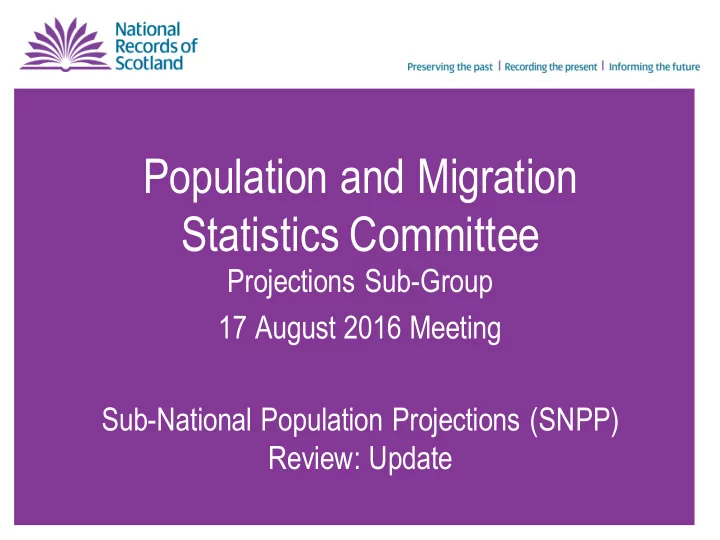

Population and Migration Statistics Committee Projections Sub-Group 17 August 2016 Meeting Sub-National Population Projections (SNPP) Review: Update
Overview of Project Why are we doing this? – The Office for National Statistics (ONS) reviewed the national method. – Move from using an outdated net migration method to incorporate the latest academic thinking on the best way to project populations in line with international best practice. How did we do this? – Academics from Leeds University reviewed our current sub-national method. – We took this work forward as a statistical exercise through our Population and Migration Statistics Committee (PAMS).
Changes to the NPP method • In 2012 ONS commissioned the Economic and Social Research Council Centre for Population Change to carry out a review of the methodology used in setting migration assumptions for the National Population Projections (NPP) and to make recommendations for future methods. • Recommendation to model international migration as flows instead of nets, and to express cross-border flows in terms of rates, rather than volumes.
Implications for our SNPP • The current SNPP methodology has been in place since 1995 some minor amendments made over the years. The system, which is written in VBA for Excel, was also created in 1995 and has had minimal changes made to it since its inception. • ONS changes to the NPP mean that the current net migration method can no longer be used and would require extensive changes to be made to the Excel programs. • Opportunity to develop a new methodology in line with changes in demographic theory since the original method was created.
The report from the academics • Professor Phil Rees of Leeds University and colleagues, Dr Pia Wohland, Dr Paul Norman and Dr Nik Lomax. • The report was completed at the beginning of May 2015. • http://www.nrscotland.gov.uk/files//statistics/consultation- groups/psg-19-08-15/paper1annexa-psg-19-08-15-snpp- academic-report.pdf
The key recommendations • SNPP should move from a single-region model to a multi-region model by changing from assuming a single net migration for each area to a rates based approach for within Scotland and rest of UK migration. • Use an adjustment developed by Statistics Canada when applying migration rates. • Keep the mortality and fertility methods the same as the current method. • Apply a method similar to the method used by the ONS in the NPP when projecting and allocating international migration.
Process • Statistical exercise with consultation with users. • Population and Migration Statistics Committee meetings. • Projections sub-group meetings – This meeting to talk through the new method and look at the impact of the changes to the method. – Previous meetings found here: http://www.nrscotland.gov.uk/statistics-and- data/statistics/user-consultations-groups-and- seminars/projections-sub-group-psg
Benefits • Review an outdated method with latest academic thinking and best practice. • A more flexible system that is easier to use and maintain. • Allow additional outputs, split projected migration flows into international, rest of UK and within Scotland. • Publish projections for all areas at the same time.
The New Methodology • Projecting a population used the same method as estimating a population: • The Cohort-Component Method
Projecting Components • The components we project are: – Births – Deaths – Special Populations – International Migration – Rest of UK Migration – Within Scotland Migration
Births & Deaths • Births and Deaths are projected by applying a scaling factor for each area to the Scotland level age-specific fertility or mortality rate and the population at risk. • The scaling factor is determined by a combination of actual births/deaths versus expected births/deaths in the reference period.
Special Populations • There are two components to Special Populations: – Armed Forces Personnel – Prisoners • In the previous system a ‘miscellaneous adjustment’ was applied after projecting each year. • In the new system an average of previously estimated special populations is removed before projecting each year and re-applied after projecting each year.
International Migration • International Migration is projected in three stages: 1. Total in and out flows (by sex) are projected using Auto-Regressive time series analysis; 2. An average of migration from the reference period (by single year of age and sex) is constrained to the totals obtained in the previous step; 3. The migration from the previous step is constrained to the migration from the national population projections. • Auto-Regressive time series is a form of Auto-Regressive Integrated Moving Average (ARIMA) time series analysis, where only the previous data is used to project the series.
Rest of UK and Within Scotland Migration • Migration is modelled using rates created from migration and population data from the reference period. • The reference period is fluid, and represents the period prior to the year being projected. • Migration is modelled by single year of age and sex for each flow between areas. • An adjustment which takes account of the destination area can be applied.
Migration Adjustment • The Migration adjustment was developed by Statistics Canada. • It is applied to within Scotland migration and rest of UK migration. • Without the adjustment only the population of the area of origin of the migrant is used in the calculation. • With the adjustment the population of both the area of origin and destination of the migrants is used in the calculation.
Geography • Projections are created for 40 processing units. • Processing units are created from splitting council areas where a national park or strategic development planning authority boundary intersects the council. • This occurs for nine councils: – Aberdeenshire – Fife – Perth & Kinross – Angus – Highland – Stirling – Argyll & Bute – Moray – W. Dunbartonshire • Each part area aggregates completely to the higher geographies.
Cairngorms National Park
Loch Lomond and The Trossachs National Park
Fife
Questions?
Recommend
More recommend